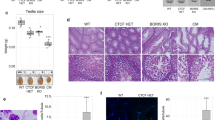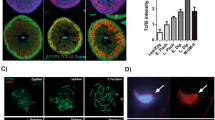Abstract
Males heterozygous for the t-haplotype form of mouse chromosome 17 preferentially transmit the t-chromosome to their progeny. Several distorter/sterility loci carried on the t-haplotype together impair flagellar function in all spermatozoa whereas the responder, Tcr, rescues t-sperm but not wild-type sperm. Thus, t-sperm have an advantage over wild-type sperm in fertilizing egg cells. We have isolated Tcr by positional cloning and show that it is a member of a novel protein kinase gene family, designated Smok, which is expressed late during spermiogenesis. Smok kinases are components of a signal cascade which may control sperm motility. Tcr has a reduced kinase activity, which may allow it to counterbalance a signalling impairment caused by the distorter/sterility loci. Tcr transgene constructs cause non-mendelian transmission of chromosomes on which they are carried, which leads to sex-ratio distortion when Tcr cosegregates with the Y chromosome.
This is a preview of subscription content, access via your institution
Access options
Subscribe to this journal
Receive 51 print issues and online access
$199.00 per year
only $3.90 per issue
Buy this article
- Purchase on Springer Link
- Instant access to full article PDF
Prices may be subject to local taxes which are calculated during checkout




Similar content being viewed by others
References
Silver,L. M. The peculiar journey of a selfish chromosome: mouse t haplotypes and meiotic drive. Trends Genet. 9, 250–254 (1993).
Fraser,L. R. & Dudley,K. New insights into the t-complex and control of sperm function. BioEssays 21, 304–312 (1999).
Lyon,M. F. Transmission ratio distortion in mouse t-haplotypes is due to multiple Distorter genes acting on a Responder locus. Cell 37, 621–628 (1984).
Silver,L. M. & Remis,D. Five of nine genetically defined regions of mouse t haplotypes are involved in transmission ratio distortion. Genet. Res. Camb. 49, 51–56 (1987).
Lyon,M. F. Male sterility of the mouse t-complex is due to homozygosity of the Distorter genes. Cell 44, 357–363 (1986).
Olds-Clarke,P. & Johnson,L. t haplotypes in the mouse compromise sperm flagellar function. Dev. Biol. 155, 14–25 (1993).
Fox,H. S. et al. Molecular probes define different regions of the mouse t complex. Cell 40, 63–69 (1985).
Schimenti,J., Vold,L., Socolow,D. & Silver,L. M. An unstable family of large DNA elements in the center of the mouse t complex. J. Mol. Biol. 194, 583–594 (1987).
Rosen,L. L., Bullard,D. C., Silver,L. M. & Schimenti,J. C. Molecular cloning of the t complex Responder genetic locus. Genomics 8, 134–140 (1990).
Bullard,D. C., Ticknor,C. & Schimenti,J. C. Functional analysis of a t complex Responder locus transgene in mice. Mamm. Genome 3, 579–587 (1992).
Schimenti,J. et al. A candidate gene family of the mouse t complex responder (Tcr) locus responsible for haploid effects on sperm function. Cell 55, 71–78 (1988).
Ewulonu,U. K., Schimenti,K., Kuemerle,B., Magnuson,T. & Schimenti,J. Targeted mutagenesis of a candidate t complex responder gene in mouse t haplotypes does not eliminate transmission ratio distortion. Genetics 144, 785–792 (1996).
Kispert,A., Stöger,R. J., Caparros,M. & Herrmann,B. G. The mouse Rsk3 gene maps to the Leh66 elements carrying the t-complex responder Tcr. Mamm. Genome 10, 794–802 (1999).
Drewes,G., Ebneth,A., Preuss,U., Mandelkow,E. M. & Mandelkow,E. MARK, a novel family of protein kinases that phosphorylate microtubule-associated proteins and trigger microtubule disruption. Cell 89, 297–308 (1997).
Hanks,S. K. & Hunter,T. The eukaryotic protein kinase superfamily: kinase (catalytic) domain structure and classification. FASEB J. 9, 576–596 (1995).
Rugh,R. The Mouse, Its Reproduction and Development (Oxford Univ. Press, Oxford, 1990).
Peschon,J. J., Behringer,R. R., Brinster,R. L. & Palmiter,R. D. Spermatid-specific expression of protamine 1 in transgenic mice. Proc. Natl Acad. Sci. USA 84, 5316–5319 (1987).
Langford,K. G. et al. Transgenic mice demonstrate a testis-specific promoter for angiotensin-converting enzyme. J. Biol. Chem. 266, 15559–15562 (1991).
Albanesi,C. et al. A cell- and developmental stage-specific promoter drives the expression of a truncated c-kit protein during mouse spermatid elongation. Development 122, 1291–1302 (1996).
Willison,K. & Ashworth,A. Mammalian spermatogenic gene expression. Trends Genet. 3, 351–355 (1987).
Braun,R. E., Behringer,R. R., Peschon,J. J., Brinster,R. L. & Palmiter,R. D. Genetically haploid spermatids are phenotypically diploid. Nature 337, 373–376 (1989).
Bennett,D., Alton,A. K. & Artzt,K. Genetic analysis of transmission ratio distortion by t-haplotypes in the mouse. Genet. Res. Camb. 41, 29–45 (1983).
Lyon,M. F. Search for differences among t haplotypes in distorter and responder genes. Genet. Res. Camb. 55, 13–19 (1990).
Tash,J. S., Kakar,S. S. & Means,A. R. Flagellar motility requires the cAMP-dependent phosphorylation of a heat-stable NP-40-soluble 56 kD protein, axokinin. Cell 38, 551–559 (1984).
Tash,J. S. et al. Identification, characterization, and functional correlation of calmodulin-dependent protein phosphatase in sperm. J. Cell Biol. 106, 1625–1633 (1988).
Carrera,A. et al. Regulation of protein tyrosine phosphorylation in human sperm by a calcium/calmodulin-dependent mechanism: identification of A kinase anchor proteins as major substrates for tyrosine phosphorylation. Dev. Biol. 180, 284–296 (1996).
Vijayaraghavan,S., Goueli,S. A., Davey,M. P. & Carr,D. W. Protein kinase A-anchoring inhibitor peptides arrest mammalian sperm motility. J. Biol. Chem. 272, 4747–4752 (1997).
Bracho,G. E., Fritch,J. J. & Tash,J. S. Identification of flagellar proteins that initiate the activation of sperm motility in vivo. Biochem. Biophys. Res. Com. 242, 231–237 (1998).
Cosson,J. A moving image of flagella: news and views on the mechanism involved in axonemal beating. Cell Biol. Int. 20, 83–94 (1996).
Lader,E., Ha,H. S., O'Neill,M., Artzt,K. & Bennett,D. tctex-1: a candidate gene family for a mouse t complex sterility locus. Cell 58, 969–979 (1989).
Huw,L. Y., Goldsborough,A. S., Willison,K. & Artzt,K. Tctex2: a sperm tail surface protein mapping to the t-complex. Dev. Biol. 170, 183–194 (1995).
Harrison,A., Olds-Clarke,P. & King,S. M. Identification of the t complex-encoded cytoplasmic dynein light chain tctex1 in inner arm I1 supports the involvement of flagellar dyneins in meiotic drive. J. Cell. Biol. 140, 1137–1147 (1998).
Patel-King,R. S., Benashski,S. E., Harrison,A. & King,S. M. A Clamydomonas homologue of the putative murine t complex distorter Tctex-2 is an outer arm dynein light chain. J. Cell Biol. 137, 1081–1090 (1997).
Mazarakis,N. et al. Isolation and characterization of a testis-expressed developmentally regulated gene from the distal inversion of the mouse t-complex. Development 111, 561–571 (1991).
Lyon,M. F. & Zenthon,J. Differences in or near the responder region of complete and partial mouse t-haplotypes. Genet. Res. Camb. 50, 29–34 (1987).
Sambrook,J., Fritsch,E. F. & Maniatis,T. Molecular Cloning, A Laboratory Manual (Cold Spring Harbor Laboratory Press, 1989).
Wilkinson,D. G. In Situ Hybridization: A Practical Approach (Oxford Univ. Press, Oxford, 1992).
Rossi,P. et al. A novel c-kit transcript, potentially encoding a truncated receptor, originates within a kit gene intron in mouse spermatids. Dev. Biol. 152, 203–207 (1992).
Acknowledgements
We thank M. F. Lyon, K. Artzt, J.-L. Guenet and J. Nadeau for mouse strains and DNA; A.-M. Frischauf for a cosmid library of the genotype tw12/tw12; B. Engist for technical assistance; S. Kuschert and H. Garbers for DNA injections; U. Stauffer for maintenance of strains; A. Bauer and M. Leitges for suggestions on kinase assays; D. Solter and R. Kemler for support; and S. Gasca, D. Solter, R. Cassada and M. Mallo for comments and suggestions on the manuscript.
Author information
Authors and Affiliations
Corresponding author
Rights and permissions
About this article
Cite this article
Herrmann, B., Koschorz, B., Wertz, K. et al. A protein kinase encoded by the t complex responder gene causes non-mendelian inheritance. Nature 402, 141–146 (1999). https://doi.org/10.1038/45970
Received:
Accepted:
Issue Date:
DOI: https://doi.org/10.1038/45970
This article is cited by
-
A toxin-antidote system contributes to interspecific reproductive isolation in rice
Nature Communications (2023)
-
Genetically-biased fertilization in APOBEC1 complementation factor (A1cf) mutant mice
Scientific Reports (2022)
-
A grazing-driven positive nutrient feedback loop and active sexual reproduction underpin widespread Noctiluca green tides
ISME Communications (2022)
-
Non-Mendelian transmission of accessory chromosomes in fungi
Chromosome Research (2022)
-
A meiotic driver alters sperm form and function in house mice: a possible example of spite
Chromosome Research (2022)
Comments
By submitting a comment you agree to abide by our Terms and Community Guidelines. If you find something abusive or that does not comply with our terms or guidelines please flag it as inappropriate.



